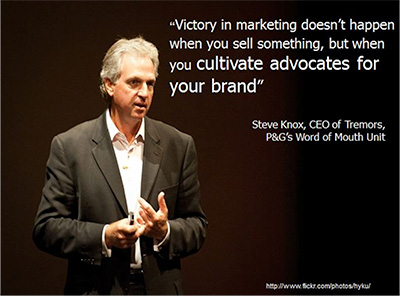
I’m a huge believer in advocates. I think they hold a lot of power but harnessing that power can be difficult.
Advocacy programs or simply a Word of Mouth program needs resources that right now might be dedicated to other projects.
Convincing the executive team to give you those resources may be challenging so here’s a few simple steps that you can take to give yourself a better shot at getting them.
First, let’s make sure we’re grounded in what an advocate is vs. an influencer. Many people sometimes don’t understand the difference. I love what Jay Baer at Convince and Convert and Zuberance did in the below infographic.

1. Advocacy is just a digital Word of Mouth program
If you take into account how people converse nowadays (social media, texting, group chat, Skype, etc…), you need to be part of the conversation. So here’s some examples:
- Social Media (Facebook, Twitter, Linkedin)
- Reviews (amazon, Yelp, Google, Epinions,)
- Recommendations Trip Advisor, Yahoo! Answers, Expert or List Blogs)
2. Advocacy directly combats negative information
This is something that is high on every executive’s list. They hate to see bad things about their products and services. If you have advocates then others (not just your marketing team) can go out and champion the company over what others have said. But if you don’t have a good product or service, then you might want to stay off the internet. 🙂
3. Advocacy Program Success Metrics must match Business Goals
Don’t go into the executive’s office with terms like follows, likes and sentiment. Go in there with statements tied to Grow Revenues, Reduce Costs and Improve Satisfaction.
You can say things like “we can potentially grow revenues by $$$$ if we have amplification of our messages because we know that if more people are talking about our product online then our sales increase by $$$$”. If you don’t have that correlation set up currently, start working on it.
But you can also say “we can potentially reduce $$$$ by having more effective knowledge management of our product/service online using advocate commentary in our help forum. Right now we employ XX people and they put up XX content pieces a month. With advocates, we could increase this by XXX or something along those lines.”
4. Advocacy is a big part of the current and future state of digital communications
This step is a bit bigger and requires a bit more work on your part to get across but I believe you’ll be a better communicator if you understand where the future of technology and communications is going.
With the current state, you can go into how the web works and how to manipulate your online reputation using the current methods.
You feed the Internet with:
- Great Content (websites & blogs)
- Constant Content
- Share via social networks
This will work for now but this system is morphing constantly.
For the future state, you’ll need to do a little reading and researching but there are several trends that will help paint a picture for your executives.
 I recommend grabbing a copy of “Age of Context” by Robert Scoble and Shel Israel. It’s an easy read and will definitely give you some thoughts on how the future is shaping up.
I recommend grabbing a copy of “Age of Context” by Robert Scoble and Shel Israel. It’s an easy read and will definitely give you some thoughts on how the future is shaping up.
They focus on five trends that are coming together to form this digital future – social media, mobile, sensors, big data and GPS location. I won’t go too much beyond this besides telling you to read the book. It’s worth the time.
I love using examples of these trends in how they are coming together. You’ll find them in the powerpoint.
So after you’ve convinced your executive team to help you build an advocacy program, I always recommend you start with an employee program first.
This way you can cut your teeth on people who will be a little more forgiving about the experience and you’ll really be ready to handle customer advocates in the future.
We’ll talk about the step by step instructions on building an employee advocacy program and a customer advocacy program in the future.
For now, though, do you have any recommendations on how to convince your executives to start an advocacy program?


Leave a Reply